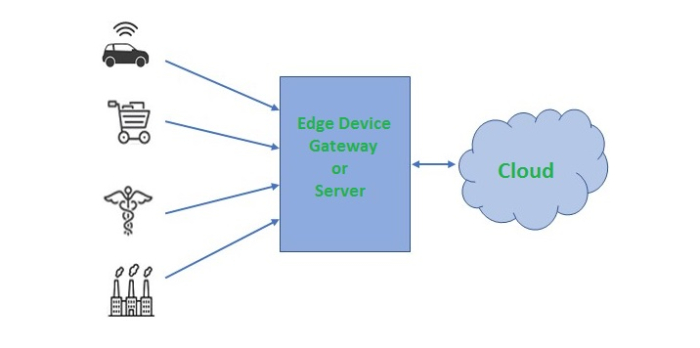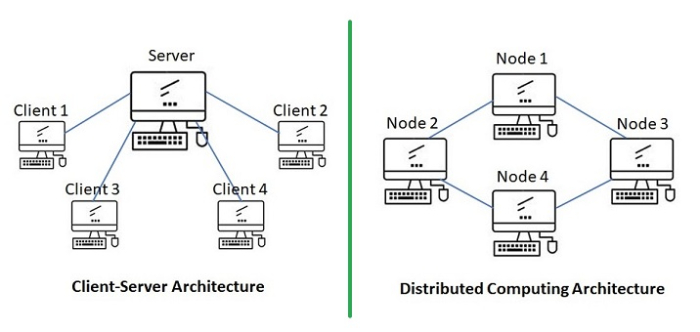
Edge Computing Vs. Distributed Computing
Information Technology used traditional centralized computing framework for many years, where one server was connected to multiple clients and was responsible to fulfill the requests coming from them. This client-server architecture has its own limitations such as possibility of scaling to some extent only vertically, ability of the server to process only certain number of requests when all clients send requests at a time, and threat to functionality if the server fails. The shortfalls were overcome by Distributed computing and then further with Edge computing frameworks.
This article briefly elaborates on each of the computing frameworks and the differences between them.
What is Edge Computing?
Edge computing is a kind of distributed computing framework which brings enterprise applications closer to data source itself, where data is generated.
With IoT, where the network of physical objects connected with each other with sensors and software exchange data over Internet, and with rolling-out of 5G-enabled mobile devices, there is inevitable generation of unprecedented data with miraculous speed and volume. Sending this massive volume of data to cloud or centralized data center comes with the issues of latency, bandwidth, and node failure. Edge computing comes to benefit here.
Edge computing can be carried out by the sensor-connected devices, by routers or gateways that transmit or receive data, or by server installations as close as possible to sites.

Advantages of Edge Computing
Edge computing addresses the limitations due to bandwidth and limitations, latency, and network congestion.
- Edge computing is effective in case of unreliable connectivity and limited bandwidth due to remote locations such as forest or sailing ships.
- The data is processed locally hence the travel time and resources required for data transmission among millions of connected devices is reduced.
- Since a huge amount of raw data is processed near the protected edge devices, it ensures data privacy and security while sending the data over networks across national boundaries.
Examples of Edge Computing
Edge Computing is practiced in a wide range of industries.
- Edge computing devices of autonomous vehicles gather data from vehicle sensors and cameras, process it, and make decisions in milliseconds for example, self-parking of vehicles.
- In the health industry, data is collected from various edge devices connected to sensors, and monitors is processed to analyze a patients condition accurately and predict remedies.
- In the retail industry, a huge amount of customer data is generated locally at point-of-sale. This data is used for sales prediction, offering insights before stocking, and any business opportunities.
- In the domain of process plants, Edge Computing offers smooth and speedy communication across very complex Supervisory Control and Data Acquisition (SCADA) networks to manage high volumes of data from sensors and Programmable Logic Controllers (PLCs). It also supports detection/prediction of a plants component.
- Edge Computing in manufacturing provides immediate response to problems occurring on assembly line, which drives quality and efficiency improvement of the product, reducing the need for human intervention.
What is Distributed Computing?
It is a framework consisting of multiple independent components of a software residing on multiple computers connected in a network and functioning as one single software. Such software is known as a Distributed Application. DC framework can contain any types of computers such as mainframes, PCs, laptops, etc., having any types of operating system such as Windows or Linux on them, connected in a LAN or a WAN.
How does Distributed Computing Work?
The Distributed Computing framework can contain multiple computers, which intercommunicate in peer-to-peer way. Means, every computer can connect to send request to, and receive response from every other computer. A computer, on joining the network, can either act as a client or server at a given time.

What is Distributed Computing Environment?
Distributed Computing Environment (DCE) is an integrated set of services and tools which are used for building and running Distributed Applications.
DC framework includes the following services −
- Remote Procedure Call (RPC) − A computer program when wants to run a subroutine from a different computer in the network, it makes a call to that remote subroutine.
- Distributed File System (DFS) − It is a manner of accessing a file in the distributed computing environment, which seems as if accessing the file that was available locally.
- Directory Service − It monitors and allocates resources in the DCE such as files, printers, scanner, servers, and other computers.
- Security Service − It supports user authentication and permits only authorized users and computers to access the secured resources.
- Thread Service − It provides the implementation of lightweight processes (threads) and synchronization of multiple threads.
- Distributed Time Service − The DCEs located globally and connected with a WAN require to synchronize for correct and timely communication among them. This service maintains global clock and synchronizes the local clocks of those DCEs.
Advantages of Distributed Computing
There are some important advantages of Distributed Computing −
- Enhanced performance due to combination of the power of multiple machines.
- In a DCE unlike Centralized Computing, even if one entity fails, there is no failure of the total system.
- There is a scope of adding extra computational resources to the existing entities in the system, often termed as scaling-up. Also, there is a scope to add new entities altogether to provide a service, which is termed as scaling-out.
Examples of Distributed Computing
Some examples of Distributed Computing frameworks are −
- Internet
- Telephone and cellular networks
Examples of some Distributed Computing applications are real time software such as −
- Airline/Cab booking
- Financial Trading
- Multi-player Games
Difference between Edge Computing and Distributed Computing
The following table highlights the prominent differences between Distributed Computing and Edge Computing −
| Key Factor | Distributed Computing | Edge Computing |
|---|---|---|
| Cost Effectiveness | Costs of operations and maintenance are higher. | Costs of operations and maintenance are lower. |
| Point of Failure | Failure of one device doesnt affect the working of entire system. Restoring from loss is little lengthy as fixing/adding of device and configuring time is more. | Failure of one edge device doesnt affect the performance of another edge device in the ecosystem. Restoring from loss is quick. |
| Scaling | More expensive than Edge Computing, takes more time to scale. | Inexpensive and quick, as the idea is to enhance computing capability of the devices. |
| Security | Use of multiple servers may lead to security compromise. | Highly secure due to data and Edge devices being in proximity. |
| Data Processing Location | At servers | In the device itself |
| Response Time | Faster than Client-Server architecture. | Faster than Distributed Computing Architecture. |
| Computing Capability | High | Low |
Having seen what Distributed Computing and Edge Computing is, it can be concluded that Edge Computing will not replace Distributed Computing. Being the paradigm of Distributed Computing, it will continue to co-exist with Distributed Computing, considering the bandwidth, latency, and connectivity challenges that drive businesses to select one over the other or both at the same time, depending on the situation.